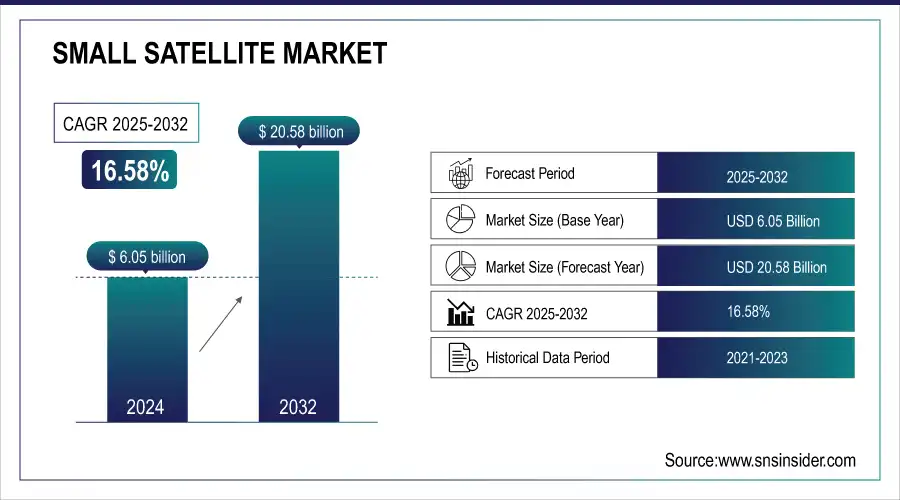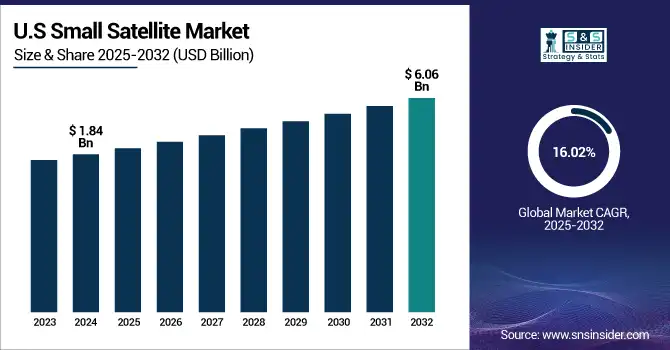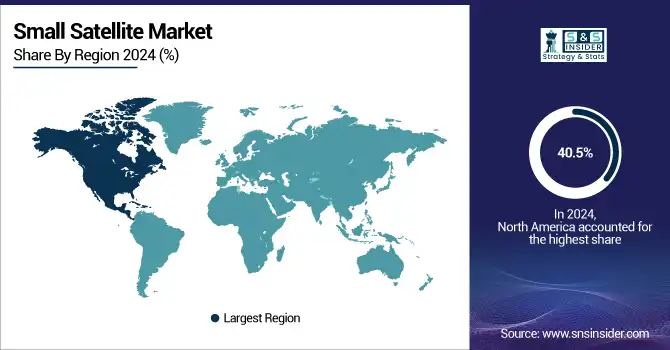Small Satellite Market Size Analysis:
The Small Satellite Market size was valued at USD 6.05 billion in 2024 and is expected to reach USD 20.58 billion by 2032, growing at a CAGR of 16.58% over the forecast period of 2025-2032.
Small satellite market trends are driven by growing deployment of satellite constellations, miniaturization, and reusable launch systems. Increasing demand from commercial sectors and advancements in payload technology also boost growth.

To Get more information on Small Satellite Market - Request Free Sample Report
The global small satellite market has witnessed significant growth due to the increasing demand for low-cost satellite missions, rapid advancements in miniaturized technologies, and expanding applications in Earth observation, communication, and scientific research. In addition, the adoption is being driven by the emerging satellite constellations planned for global coverage, especially in hard-to-reach area or remote regions. Besides, increased participation from private players, government backing for space programs and availability of reusable launch vehicles are driving down the launch cost and promoting small satellite launches at wearer prices and competent levels globally.
SpaceX’s Starlink program launched over 1,500 small satellites in 2024 alone, furthering the global constellation trend for broadband connectivity.
The U.S. Small satellite market size was valued at USD 1.84 billion in 2024 and is expected to reach USD 6.06 billion by 2032, growing at a CAGR of 16.02% over the forecast period of 2025-2032. The U.S. Small satellite market is growing due to strong government space initiatives, rising commercial demand for Earth observation and broadband services, and the presence of leading players, such as SpaceX, Planet Labs, and Rocket Lab.

Small Satellite Market Dynamics:
Drivers:
-
Low-Cost Missions and Miniaturization Propel Growth in Global Small Satellite Market Across Diverse Applications
Although many of the small satellite trends are applicable to small and large satellites globally, the globally small satellite blueprint market is mainly supported by the rising demand for low-cost satellite missions, faster deployment of satellite constellations, and growing utilization of satellites for earth observation, communication and scientific research. Miniaturization of satellite components at hyper-accelerated pace and increasing defense interest in surveillance and reconnaissance applications, are other key driving factors. Improved reusability of launch vehicles has lowered costs and clustered satellite launches allowing more satellite launches for a dollar.
The average satellite development timeline for smallsats has been reduced to 12–18 months compared to 3–5 years for traditional large satellites.
Restraints:
-
Limited Payload and Lifespan of Small Satellites Pose Challenges for Advanced Space Mission Applications
The small satellites are with limited payload capability and operational lifetime that restrict the functionality of high-performance missions, which is the major restraint in the small satellite market. Much smaller than a standard “small” satellite, these satellites may have lower power, limited on-board data storage and lower resolution sensors than what is typically found on a larger satellite making them unsuitable for some advanced applications, such as deep space exploration or independent high-bandwidth communications.
Opportunities:
-
Emerging Markets and Tech Innovation Unlock New Opportunities in Remote Sensing and Global Satellite Connectivity
Remote sensing for climate monitoring, global internet coverage in underserved regions, and data analytics services enabled by satellite imagery are some of the new opportunities that are opening up in the small satellite industry. Public-private collaboration will continue to grow, space startups will look to attract more funding, and emerging space programs in the Asia-Pacific and Latin America are all likely to create new growth opportunities.
APAC expansion included India’s IN-SPACe approving more than 50 private space missions in 2024, many involving smallsats for IoT, imaging, and connectivity
Challenges:
-
Rising Orbital Congestion and Regulatory Gaps Challenge the Rapid Growth of Small Satellite Constellations
Space traffic management and orbital debris is another challenge. The proliferation of small satellite constellations has greatly increased the risk of collision and orbital congestion in Low Earth Orbit (LEO). Moreover, the lack of regulations surrounding spectrum allocation, satellite licensing, and cross-border coordination adds to operator headaches especially for startups and international companies looking to scale quickly in multiple geographies.
Small Satellite Market Segmentation Outlook:
By Satellite Type
In 2024 the small satellite market was dominated by the mini satellites (100–500 kg) with 34.3% share of the total deployment. They dominate as they strike a very good compromise between size, performance and cost, making it a very good choice for Earth observation, telecommunications and defence missions. Compared to micro and nano satellites, they have a larger payload capacity and offer more onboard power, allowing for more sophisticated sensor and data-handling capabilities.
During 2025-2032 nano satellites (1–10 kg) are predicted to receive the fastest CAGR owing to relatively lower development cost, shorter build timelines, and suitability for rideshare launch programs. The growing use of CubeSats for various applications including research, imaging, and IoT by universities, startups, and commercial enterprises is propelling the rapid growth of this segment.

By Application
The communication held the highest share of small satellite market, which was 34.5% in 2024 and is expected to grow at the fastest CAGR over 2025-2032. This dominance and growth will continue to propel by the increasingly broad-based demand for broadband infrastructure globally, particularly in rural and remote areas. The proliferation of communications-driven small satellites, driven by satellite internet constellations, such as Starlink, OneWeb and Amazon Kuiper. At the same time, several commercial and government trends are dialing up demand for small satellites of various types for Internet of Things networks, and maritime and aviation connectivity and real-time data relay services.
By End-User Industry
Fueled by the rapid growth of private satellite constellations for Earth observation, broadband connectivity and data analytics services, commercial end-users led the small satellite market with a 46.0% share in 2024. Commercial deployments continue to be led by companies, such as SpaceX, Planet Labs, and Spire Global, which are poised to take advantage of the increasing order for agriculture, transportation, and infrastructure.
Rising investments on satellite-based surveillance, secure communication and reconnaissance missions are driving growth of the Government & Military segment, which is anticipated to be the fastest CAGR during the forecast period. Global climate change has heightened the need to support space capabilities for humanitarian assistance and disaster response while governments are also strengthening capabilities for national security in space. Policy initiatives to promote public-private partnerships, along with targeted launch initiatives, will ensure a steady demand stream for small satellite systems from both military and civilian customers.
By Orbit
The low-earth orbit (LEO) segment accounted for the highest share in the small satellite market, contributing to nearly 52.2% share in 2024, and is anticipated to witness the fastest growth during the forecast period, owing to its application in urgent communication and monitoring. This is due its suitability for Earth observation, low-latency communication, and frequent revisit rates which allows for such dominance. Most of the planned small satellite constellations are in LEO due to lower launch costs and faster deployment cycles, which is well suited for commercial, defense and scientific applications where real-time data and near-global coverage are required.
Small Satellite Market Regional Insights:
North America captured 40.5% share of small satellite market in 2024 owing to more robust government space programs, advanced launch infrastructure, and major commercial players, such as SF, Planet Labs, and Rocket Lab, This region powered by strong public-private partnerships, high R&D investments, and an established ecosystem around satellite manufacturing, launch services, and data analytics old and new demand for Earth observation, military surveillance, and broadband continue to strengthen North America as a leader in the global market.

Get Customized Report as per Your Business Requirement - Enquiry Now
The U.S., dominates North America with its advanced aerospace industry, extensive military-directed investments and technology exports, and groundbreaking commercial space companies pushing innovation in small satellite design and deployment.
The APAC region is projected to grow at the highest CAGR of 17.48% over 2025-2032 in the small satellite market due to the growing government investments, increasing private sector participation and demand for connectivity and Earth observation. The region-wide trend of developing small satellite missions for national development purposes, such as weather forecasting and remote sensing, and national security has been progressively carried out by the countries in the region. The surge in low-cost manufacturing capabilities continues to stimulate growth, aided by regulatory policies and bilateral agreements. Due to the region's rapidly advancing and developing space ecosystem, it stands out as a natural future contributor toward global satellite launch and development.
The small satellite market share in the Asia-Pacific is dominated by China whose aggressive satellite launch schedule coupled with state-backed space programs are directed into substantial funding on defense, communications, and Earth observation technologies.
The ESA (European Space Agency), national space programs (mostly in Western/Eastern Europe), and private industry are boosting Europe's small satellite market growth. Earth observation, climate monitoring, and secure communications are regional focuses, which includes interest in CubeSats and smallsat constellations. The UK, Germany and France are all currently investing in small satellite infrastructure, manufacture and launch capabilities. Innovation and competitiveness in the European small satellite ecosystem continue to be fueled by public-private partnerships and cross-border collaborations.
Latin America and the Middle East & Africa have recently gained traction as growing small satellite markets for emerging applications including space-based agricultural, disaster-monitoring, environmental management, and connectivity solutions. Regional Space agencies and a number of Latin American academic institutions are launching small satellite missions, as demonstrated by Brazil, Mexico, and Argentina. In a similar fashion, Middle Eastern countries, such as the UAE and Saudi Arabia are emphasizing satellite technology to enhance national security, weather forecasting, and to monitor infrastructure. Improving regional participation in the global small satellite ecosystem through expanded collaborations, academic participation and government-supported space activities.
Small Satellites Companies are:
The Key Players in Small Satellite Market are SpaceX, Planet Labs, OneWeb, Sierra Space, Blue Canyon Technologies, L3Harris Technologies, AAC Clyde Space, Terran Orbital, Spire Global, NanoAvionics, Satellogic, ICEYE, Rocket Lab, Exolaunch, Tyvak, OHB SE, Axelspace, ISISPACE, D-Orbit, and Pixxel.
Recent Developments:
-
In May 2025, SpaceX launched 28 Starlink satellites into LEO using Falcon 9 for its 28th successful mission with booster B1067; part of its ongoing expansion of the Starlink broadband constellation.
-
In January 2025, Planet announced it would launch its high-resolution Pelican‑2 satellite along with 36 SuperDove satellites (Flock 4G) on SpaceX’s Transporter‑12 mission from Vandenberg, marking a major upgrade in their imaging constellation.
| Report Attributes | Details |
| Market Size in 2024 | USD 6.05 Billion |
| Market Size by 2032 | USD 20.58 Billion |
| CAGR | CAGR of 16.58% From 2025 to 2032 |
| Base Year | 2024 |
| Forecast Period | 2025-2032 |
| Historical Data | 2021-2023 |
| Report Scope & Coverage | Market Size, Segments Analysis, Competitive Landscape, Regional Analysis, DROC & SWOT Analysis, Forecast Outlook |
| Key Segments | • By Satellite Type (Mini Satellites (100–500 kg), Micro Satellites (10–100 kg), Nano Satellites (1–10 kg), Pico Satellites (<1 kg), and Femto Satellites (<100 g)) • By Application (Earth Observation & Remote Sensing, Communication, Scientific Research & Exploration, Technology Demonstration, Surveillance & Security, and Meteorology) • By End-User Industry (Commercial, Government & Military, Civil, and Academic & Research Institutions) • By Orbit (Low Earth Orbit (LEO), Medium Earth Orbit (MEO), Geostationary Orbit (GEO), Sun-Synchronous Orbit (SSO), and Polar Orbit) |
| Regional Analysis/Coverage | North America (US, Canada, Mexico), Europe (Germany, France, UK, Italy, Spain, Poland, Turkey, Rest of Europe), Asia Pacific (China, India, Japan, South Korea, Singapore, Australia, Taiwan, Rest of Asia Pacific), Middle East & Africa (UAE, Saudi Arabia, Qatar, South Africa, Rest of Middle East & Africa), Latin America (Brazil, Argentina, Rest of Latin America) |
| Company Profiles | SpaceX, Planet Labs PBC, OneWeb, Sierra Space, Blue Canyon Technologies, L3Harris Technologies, AAC Clyde Space, Terran Orbital, Spire Global, NanoAvionics, Satellogic, ICEYE, Rocket Lab, Exolaunch, Tyvak, OHB SE, Axelspace, ISISPACE, D-Orbit, Pixxel. |

